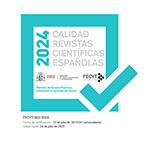Gender equality as measurable analytic category in politics: Gender Presence Scale and Indicators to Gender Symmetry
Abstract
Introduction. Gender equality is both a theoretical notion and an analytical category, as well as a social right. This triple conception generates multiple interferences when it comes to its analytical definition, especially in quantitative studies. It is a problem how to measure gender equality according to objective criteria and determine the degree of women's access to power. Objectives. This paper explores these issues by analyzing female participation in the local political arena after the entry into force of the Equality Law. The aim is to alleviate the lack of precise instruments to measure gender equality in its different manifestations throughout the political process. Methodology. The research has been organized in two parts: the examination of the new scenario of political participation after the application of Organic Law 3/2007, analyzing the concatenation of inequalities in different phases of the process to avoid the biases derived from the comparison; and the articulation of two new analytical tools based on the delimitation of the degrees of equality and inequality. Results. We present Gender Presence Scale (EPG) and Indicators to Measure the Distance to Gender Symmetry (DSG). Both allow measuring parity in the different phases of the process, in a standardized way, facilitating the effective and interrelated comparison of the different categories, elements and contexts. They also serve to evaluate the degree of equality of the female presence in each of them and, even, to foresee the short-medium term perspectives. Conclusions and discussion. This comparative study represents an advance in the methodology used up to now, being more precise, operative, and productive; it can also be extrapolated to any other field.
Downloads
Article download
License
In order to support the global exchange of knowledge, the journal Investigaciones Feministas is allowing unrestricted access to its content as from its publication in this electronic edition, and as such it is an open-access journal. The originals published in this journal are the property of the Complutense University of Madrid and any reproduction thereof in full or in part must cite the source. All content is distributed under a Creative Commons Attribution 4.0 use and distribution licence (CC BY 4.0). This circumstance must be expressly stated in these terms where necessary. You can view the summary and the complete legal text of the licence.











